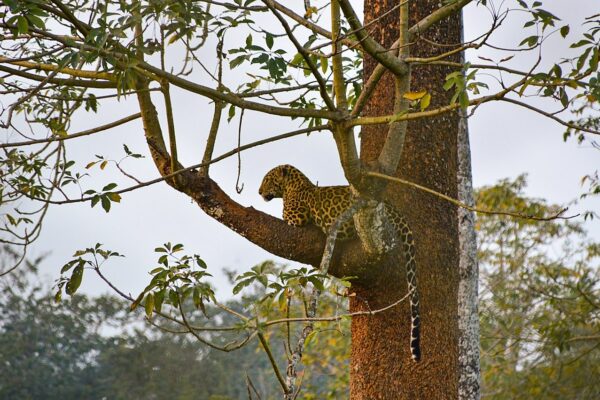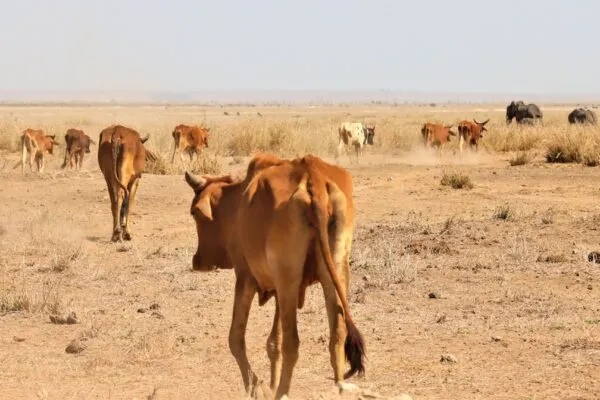Human-Wildlife Conflicts in India, Cases on Rise
In past decades, cases of human-wildlife conflicts in India have rapidly increased, resulting in the loss of human lives and wildlife too
The series of human-wildlife conflicts goes way back to primitive times, especially in a country like India which has a huge human population and a vast range of biodiversity. The land is limited and so are the resources.
But, since the human settlements have reached the edges of forests, episodes of human-animal conflicts have increased as the wild animals often wander into the human colonies due to the dwindling forest area.
With the increasing urbanisation, the human-wildlife conflicts in India are on a rise, creating huge risks for both animals and humans alike.
Human-Wildlife Conflicts in India
Human-wildlife conflicts in India are quite common as many people live close to forests. As per the data collected by the Ministry of Environment, Forest and Climate Change (MoEF&CC), due to human-elephant conflict alone, 2361 people were killed between 2014-15 to 2018-2019.
A total of 276 people were killed due to the human-tiger conflict between 2014-15 to 2019-2020. Apart from tigers and elephants, there are other animals such as snakes, leopards, bears and wild boars that cause many human deaths.
According to the ministry data from the five years of 2014-15 to 2018-19, a total of elephants died due to train accidents, 333 elephants died due to electrocution, 71 elephants died due to poaching and 29 elephants died due to poisoning.
The Uttarakhand Forest Department revealed that 56 per cent of the human deaths in man-animal conflicts in 2020 occurred in the last four months of the year. Reportedly, 62 people died and 286 were injured in such incidents.
The maximum number of casualties – 30 deaths and 85 injuries – were by leopard attacks, followed by snake bites where 15 people died and 53 injuries occurred, elephant attacks caused 11 deaths and 8 injuries, and bear attacks caused 86 injuries.
Each year, human-elephant conflict results in about 500 human deaths while over 100 elephants die due to human-relatives activities, such as poaching for ivory or meat, poisoning, electrocution and collision with trains.
Examples of Human-Wildlife Conflicts in India
- Last year, a six-year-old tigress named Avni was shot dead by a private hunter’s son for allegedly killing 13 people in Maharashtra. After the incident, there was an outpouring of grief, anger, and protests from many regions of the country. Maharashtra’s government was criticized for ordering the kill despite opposition from several stakeholders.
- Just a day after the ‘ghastly murder’ of Avni, another tigress was run over and beaten to death by angry villagers after she mauled a 50-year-old man in Utter Pradesh. On the same day, a leopard snuck into the Gujrat secretariat and the sprawling complex had to be cordoned off.
- Seven elephants died of electrocution in Odisha only a week before that incident. An adult female elephant was deliberately electrocuted in the state’s Rourkela forest division for frequently damaging crops in the area. The killing was labeled a ‘revenge killing’ which is becoming an increasingly common phenomenon as human-animal conflict gradually becomes the order of the day.
- In Assam, 62 elephants have died since January this year while 63 people have been killed in human-elephant conflicts.
- As per the state forest department data, Uttarakhand has lost 34 lives to human-wildlife conflicts in 2019. The data only includes deaths due to attacks by wild animals such as leopards, elephants, bears, and tigers.
- In a fifth such incident in recent weeks, a leopard mauled a 65-year-old labourer to death in Uttar Pradesh’s Bijnor district. Hours after killing the labourer, a farmer was also attacked by a big cat, near the same spot. The animal has been declared a ‘man-eater.’
- According to the Environment Ministry, 1,608 human beings were killed between 2014 and 2017 due to such conflicts – an average of more than one human being every day. In the last five years, over 2,000 people were killed by elephants and around 200 lost their lives in tiger attacks.
- Wildlife Protection Society of India (WPSI), a Delhi-based NGO revealed that 1,000 tigers were killed by poachers in the last 2 decades. Whereas, there have been 650 instances of roadkill in the last 5 years. 32,000 animals including cattle, elephants, lions, and leopards were killed on railway tracks in the last 3 years.
- On January 21, 2020, the carcass of a female jackal was found near the Bandhwari landfill site in Haryana. The forest officials suspect the cause of death could have been a road accident as the body showed signs of impact near the head.
According to the officials, the animal was pregnant and only an autopsy could determine the exact cause of death. The species, which is commonly seen in Haryana, is protected under Schedule-III of the Wildlife Protection Act (1972). And the constant incidents of conflict and inhumane cases such as roadkill are disheartening and threaten the endangered species.
- In the recent episodes of human-wildlife conflicts in India, on January 25, 2020, a 42-year-old woman was killed by a tiger in the Brahmapuri forest division of Chandrapur district, Maharashtra. The woman was attacked by the animal while she was out working in her fields.
- A video of a man being attacked by a tiger went viral on social media on January 25, 2020. The man pretended to be dead when the tiger had both of his paws on the man’s chest. Apparently, the trick worked and man’s life was spared. The presence of mind and ability to remain calm in the grasp of death that were shown by the man was highly applauded on social media.
You want to see how does a narrow escape looks like in case of encounter with a #tiger. #Tiger was cornered by the crowd. But fortunately end was fine for both man and tiger. Sent by a senior. pic.twitter.com/1rLZyZJs3i
— Parveen Kaswan, IFS (@ParveenKaswan) January 25, 2020
- Cases of elephant electrocution are not news in India. On January 27, 2020, a wild elephant bumped into an electric pole, knocked live wires on itself, and died on the spot. Reportedly, the animal was being chased out of a village in the Chittoor district of Andhra Pradesh by the officials.
The elephant was part of a herd that approached the fields near a village from the Koundinya Wildlife Sanctuary. Afraid that the animals would trample their crops, villagers called forest officers to help chase the herd away. It was during this chasing process that one of them ran into an electric pole and got electrocuted.
- On January 30, Bollywood actor Randeep Hooda shared a video on Twitter, where an injured leopard was lying on the road while the onlookers recorded the incident but did nothing to help the animal.
Yesterday it was leopard, today a elephant. These #roadkills will keep happening, rather they will increase with time. Robust mitigation measures on proposed and existing projects is a must. #SaveWildlife
@PrakashJavdekar @nitin_gadkari @moefcc @MORTHIndia @ntca_india pic.twitter.com/1E7k53k7NB— Randeep Hooda (@RandeepHooda) January 30, 2020
- In another episode, a leopard attacked a girl when she went into the forest to collect firewood in Vadodara. The animal grabbed the 12-year-old girl by the neck and dragged her into the woods. She later was found dead when her companion brought back help.
According to a report, a leopard that had emerged from the Kamdanam forest ran into a house in Shadnagar town in Telangana state. The area was immediately evacuated and the forest officials worked hard to catch the big cat.
- Recently, two leopards and two sloth bears were electrocuted by poachers in Maharashtra’s Chandrapur. The poachers used the 11 KV electric power supply line to electrify the wire laid along the ground. Forest Department suspects the involvement of local poachers hunting for bushmeat.
2 leopards, 2 bears n a deer were electrocuted in Bhadravati near Chandrapur.
Movement of leopard was rexorded couple of days ago. Dept says since these animals did not die in forest land hence not in their jurisdiction. @OfficeofUT @AUThackeray @ntca_india pic.twitter.com/eRUnQT3dwS— Randeep Hooda (@RandeepHooda) February 1, 2020
- In another incident, a leopard died in captivity in Sasan, Gujarat. Days after it was captured for allegedly attacking human beings, the male leopard died in a facility in the state.
- However, there are such incidents as well where mankind has provided proof of inhuman brutality. Recently, a pregnant elephant died in Kerala after it ate a firecracker-filled pineapple, allegedly placed by locals to kill the wild boars who destroy their crops.
There has been an increase in human-wildlife conflicts in India in past decades, with incidents ending in the loss of life – both human and animal.
Unavoidable Man-Animal Conflicts in India
The escalating human population burdens the land and resources of the country. Man encroaches on the forest area and natural habitat of the animals which creates conflict scenarios.
Conflicts between humans and wildlife are one of the main threats to the continued survival of many endangered species found in India and are also a significant threat to the local human population.
Human-animal conflicts in India can be attributed to a dozen of reasons, including human population explosion, shrinking forest cover, poaching, relentless unplanned urbanisation, which entails electrification penetrating forest areas, increasing road density, destruction of natural wildlife corridors, agricultural expansion, and cultivation up to forest boundaries.
Humans need to understand the need for living in harmony with wildlife species while keeping a safe distance. It is time to move from conflict to co-existence.


